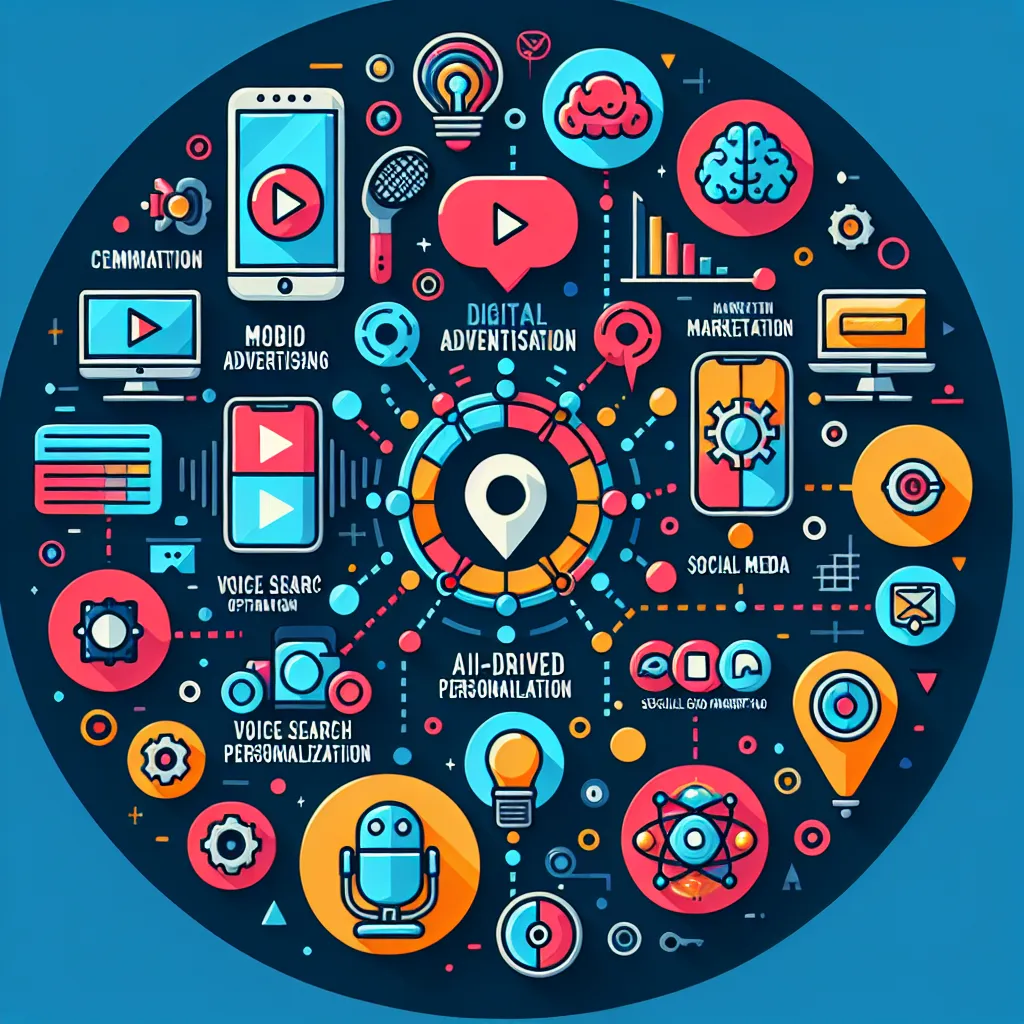The IELTS Reading section is a crucial component of the test, assessing your ability to comprehend complex texts and extract relevant information. Today, we’ll focus on a topic that has become increasingly prevalent in recent years: digital advertising. Based on our analysis of past IELTS exams and current trends, the subject of “Top trends in digital advertising” is likely to appear in future tests due to its relevance in today’s digital-centric world.
Nội dung bài viết
Let’s dive into a practice reading passage and questions that mirror the format and difficulty level you might encounter in an actual IELTS exam. This exercise will help you sharpen your reading skills while familiarizing yourself with key concepts in digital advertising.
 Digital advertising trends infographic
Digital advertising trends infographic
Reading Passage
The Evolution of Digital Advertising
Digital advertising has undergone a remarkable transformation in recent years, driven by technological advancements and changing consumer behaviors. As businesses strive to capture the attention of increasingly tech-savvy audiences, several key trends have emerged that are reshaping the landscape of online marketing.
One of the most significant developments is the rise of artificial intelligence (AI) and machine learning in advertising. These technologies are revolutionizing the way companies target and engage with potential customers. AI-powered algorithms can analyze vast amounts of data to predict consumer preferences and behaviors, allowing for highly personalized ad experiences. This level of customization not only enhances the relevance of ads but also improves conversion rates and return on investment for advertisers.
Another trend gaining momentum is the shift towards video content. With the proliferation of high-speed internet and mobile devices, video has become a dominant format for consuming online content. Consequently, advertisers are increasingly leveraging video platforms to create engaging and shareable content. Short-form videos, in particular, have surged in popularity, with platforms like TikTok and Instagram Reels offering new avenues for brands to connect with younger audiences.
The growing importance of voice search optimization is also reshaping digital advertising strategies. As smart speakers and voice-activated devices become more prevalent in homes and workplaces, businesses are adapting their SEO and content strategies to cater to voice-based queries. This shift requires a more conversational approach to content creation and a focus on long-tail keywords that mirror natural speech patterns.
Privacy concerns and data protection regulations have also had a significant impact on the digital advertising landscape. With the implementation of laws like the General Data Protection Regulation (GDPR) in Europe and the California Consumer Privacy Act (CCPA) in the United States, advertisers are being forced to rethink their data collection and usage practices. This has led to a greater emphasis on first-party data and the development of new targeting techniques that respect user privacy while still delivering effective ad campaigns.
Lastly, the concept of “shoppable” content is gaining traction across various platforms. Social media networks are integrating e-commerce features that allow users to make purchases directly within their apps, blurring the lines between content consumption and online shopping. This trend is particularly evident on platforms like Instagram and Pinterest, where users can seamlessly transition from discovering products to buying them without leaving the app.
As digital advertising continues to evolve, marketers must stay abreast of these trends to remain competitive in an increasingly crowded online space. The ability to adapt to new technologies and changing consumer preferences will be crucial for businesses looking to maximize their digital advertising efforts in the years to come.
Questions
True/False/Not Given
- AI-powered algorithms can predict consumer preferences with 100% accuracy.
- Video content has become more popular due to the widespread availability of high-speed internet.
- Voice search optimization requires a focus on short-tail keywords.
- The GDPR applies only to companies based in Europe.
- All social media platforms now offer integrated e-commerce features.
Matching Headings
Match the following headings to the paragraphs in the passage. There are more headings than paragraphs, so you will not use all of them.
A. The rise of AI in advertising
B. The decline of traditional advertising methods
C. Video content dominance
D. Voice search and its impact on advertising
E. Privacy regulations reshaping ad strategies
F. The future of outdoor advertising
G. Shoppable content integration
Multiple Choice
-
According to the passage, which of the following is NOT mentioned as a benefit of AI in advertising?
a) Improved targeting
b) Enhanced ad relevance
c) Better conversion rates
d) Reduced advertising costs -
Which platform is specifically mentioned as an example of short-form video content?
a) YouTube
b) Facebook
c) TikTok
d) LinkedIn -
What is the main challenge posed by voice search optimization for advertisers?
a) Creating longer content
b) Focusing on visual elements
c) Adopting a more conversational approach
d) Increasing advertising budgets -
Which of the following best describes the concept of “shoppable” content?
a) Content that can be purchased by advertisers
b) Ads that allow direct purchases within the platform
c) User-generated content featuring product reviews
d) Premium content available only to paying subscribers -
Based on the passage, what is likely to be most important for marketers in the future of digital advertising?
a) Focusing solely on traditional advertising methods
b) Ignoring new technologies and trends
c) Adapting to new technologies and consumer preferences
d) Prioritizing quantity over quality in ad campaigns
Answer Key and Explanations
True/False/Not Given
- Not Given – The passage mentions AI’s ability to predict preferences but doesn’t claim 100% accuracy.
- True – The text states, “With the proliferation of high-speed internet and mobile devices, video has become a dominant format.”
- False – The passage mentions “a focus on long-tail keywords that mirror natural speech patterns.”
- Not Given – The GDPR is mentioned, but its specific application is not detailed.
- False – The passage states that this trend is “particularly evident on platforms like Instagram and Pinterest,” implying not all platforms have this feature.
Matching Headings
Paragraph 2: A. The rise of AI in advertising
Paragraph 3: C. Video content dominance
Paragraph 4: D. Voice search and its impact on advertising
Paragraph 5: E. Privacy regulations reshaping ad strategies
Paragraph 6: G. Shoppable content integration
Multiple Choice
- d) Reduced advertising costs – This benefit is not explicitly mentioned in the passage.
- c) TikTok – The passage specifically mentions TikTok as an example of short-form video content.
- c) Adopting a more conversational approach – The text states that voice search optimization “requires a more conversational approach to content creation.”
- b) Ads that allow direct purchases within the platform – This aligns with the description of shoppable content in the passage.
- c) Adapting to new technologies and consumer preferences – The concluding paragraph emphasizes the importance of adaptation for future success.
Common Mistakes to Avoid
- Overlooking key qualifiers in True/False/Not Given questions.
- Matching headings based on single words rather than overall meaning.
- Choosing multiple-choice answers based on personal knowledge rather than information in the text.
- Failing to read all options before selecting an answer.
- Misinterpreting implied information as directly stated facts.
Vocabulary
- Transformation (noun) – /ˌtrænsfəˈmeɪʃən/ – a complete change in something
- Proliferation (noun) – /prəˌlɪfəˈreɪʃən/ – rapid increase in the number or amount of something
- Leverage (verb) – /ˈlevərɪdʒ/ – use (something) to maximum advantage
- Prevalent (adjective) – /ˈprevələnt/ – widespread in a particular area or at a particular time
- Conversational (adjective) – /ˌkɑːnvərˈseɪʃənl/ – relating to or characteristic of informal spoken language
Grammar Focus
Passive Voice: Used frequently in academic and formal writing to emphasize the action rather than the actor.
Example from the text: “These technologies are revolutionizing the way companies target and engage with potential customers.”
Formula: Subject + be + past participle (+ by + agent)
Practice: Transform this active sentence into passive voice:
Active: Advertisers are leveraging video platforms to create engaging content.
Passive: Video platforms are being leveraged (by advertisers) to create engaging content.
Tips for IELTS Reading Success
- Practice time management: Allocate your time wisely across all sections of the reading test.
- Skim and scan effectively: Quickly identify key information without reading every word.
- Develop your vocabulary: Regularly learn new words and their contextual usage.
- Read actively: Engage with the text by predicting, questioning, and summarizing as you read.
- Familiarize yourself with question types: Practice with all IELTS reading question formats.
Remember, success in IELTS Reading comes from consistent practice and developing effective strategies. Focus on understanding the overall meaning of passages while honing your ability to quickly locate specific details. By staying informed about current topics like digital advertising trends, you’ll be better prepared for the diverse subjects that may appear in the IELTS Reading test.
For more IELTS preparation tips and resources, check out our articles on top tips for digital marketing and the impact of digital marketing on consumer choices. These will not only help you with reading practice but also provide valuable insights into related topics that could appear in your IELTS exam.


